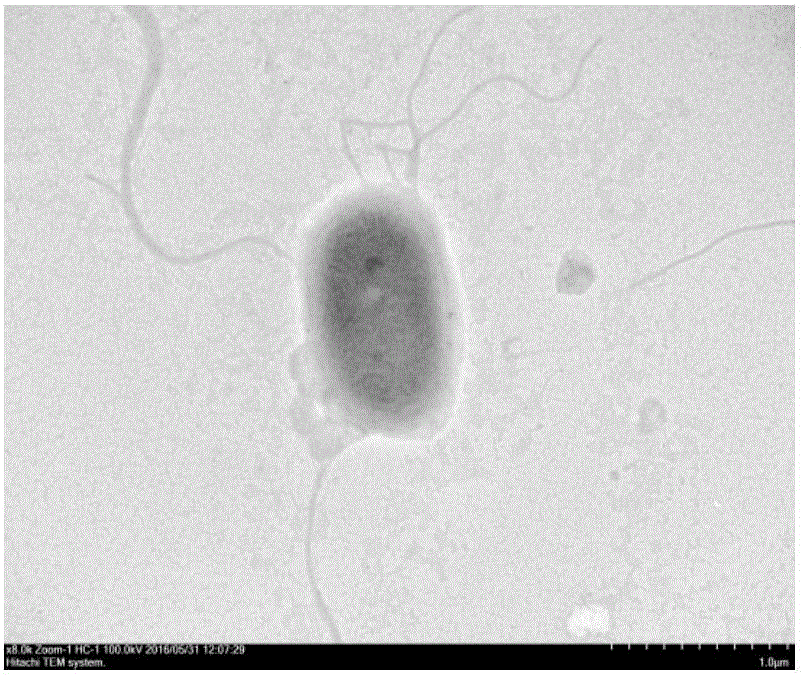Benzoyl urea insecticide degrading bacteria, bacterial agent by using same and application of benzoyl urea insecticide degrading bacteria
A technology of benzoyl urea and insecticide, which is applied in the field of benzoyl urea insecticide degrading bacteria and the bacterial agent produced by it, can solve the problems of no degradation and other problems, and achieve the protection of health and good removal effect , Reduce the effect of phytotoxicity on crops
- Summary
- Abstract
- Description
- Claims
- Application Information
AI Technical Summary
Problems solved by technology
Method used
Image
Examples
Embodiment 1
[0031] Isolation and Characterization of Strain M6:
[0032] The enrichment matrix used to enrich the benzoylurea insecticide-degrading strain was taken from the activated sludge of the pesticide wastewater biochemical treatment tank of Hainan Runhe Pesticide Co., Ltd., Haikou, Hainan, and 5.0 g of the activated sludge was added to the basic salt medium In, add 50mg·L -1 Diflubenzuron, cultured at 30°C and 180rpm for 7 days, transferred to the same culture medium with a 5% inoculum size, transferred continuously for 3 times, and diluted the enrichment solution in gradient, taking 10 -4 ~10 -7 0.1mL of each diluted enrichment solution was applied to the -1 On the solid medium plate of diflubenzuron, after culturing at 30°C for 4 days, pick the grown single colony and inoculate it in a medium containing 100mg·L -1 Various benzoylurea insecticides (hexaflumuron, diflubenzuron, and diflubenzuron) were cultured at 30°C and 180 rpm for 5 days to verify their degradation effects. ...
Embodiment 2
[0037] Biodegradation test of bacterial strain M6 to benzoylurea insecticides in medium:
[0038] In the basal salt culture medium (with embodiment 1) respectively, add final concentration and be 100mg L -1 Hexaflumuron, diflubenzuron, and diflubenzuron were inserted into the bacterial strain M6 bacterium liquid according to the inoculation amount of 1% volume ratio, and the final concentration of 100mg L was added to the basic salt medium (same as Example 1) respectively. -1 Hexaflumuron, diflubenzuron, and diflubenzuron were used to inoculate the inactivated bacterial strain M6 with an inoculation amount of 1% volume ratio as control 1, control 2, and control 3, cultivated in a constant temperature shaker at 30°C, and regularly sampled. The method for verification of the degradation effect in Example 1 detects the degradation of hexaflumuron, diflubenzuron, and diflubenzuron by high-performance liquid chromatography, and the HPLC analysis spectrum of the degradation result i...
Embodiment 3
[0043] Preparation method of degrading bacteria agent
[0044] 1) Inoculate the cultured test tube solution of the strain M6 into the fermentation medium with an inoculation amount of 1% by volume, and vibrate and cultivate to the logarithmic phase to obtain the fermentation strain;
[0045] 2) Inoculate 500 liters of 70% (based on the volume of the fermenter, the same below) with an inoculation amount of 8% (v / v, based on the volume of the culture medium) of the above-mentioned cultured fermentation strains into 500 liters of liquid Cultivate in the medium of the seed tank, cultivate to the logarithmic growth phase, and obtain the seed liquid;
[0046] 3) The inoculation amount of the seed solution is 8% (v / v, based on the volume of the medium, the same below) into the culture medium of the production tank with a liquid volume of 70%.
[0047] 4) During the cultivation process of seed tanks and production tanks, the ventilation rate of sterile air is 1:0.8, the stirring spee...
PUM
 Login to View More
Login to View More Abstract
Description
Claims
Application Information
 Login to View More
Login to View More - R&D
- Intellectual Property
- Life Sciences
- Materials
- Tech Scout
- Unparalleled Data Quality
- Higher Quality Content
- 60% Fewer Hallucinations
Browse by: Latest US Patents, China's latest patents, Technical Efficacy Thesaurus, Application Domain, Technology Topic, Popular Technical Reports.
© 2025 PatSnap. All rights reserved.Legal|Privacy policy|Modern Slavery Act Transparency Statement|Sitemap|About US| Contact US: help@patsnap.com



